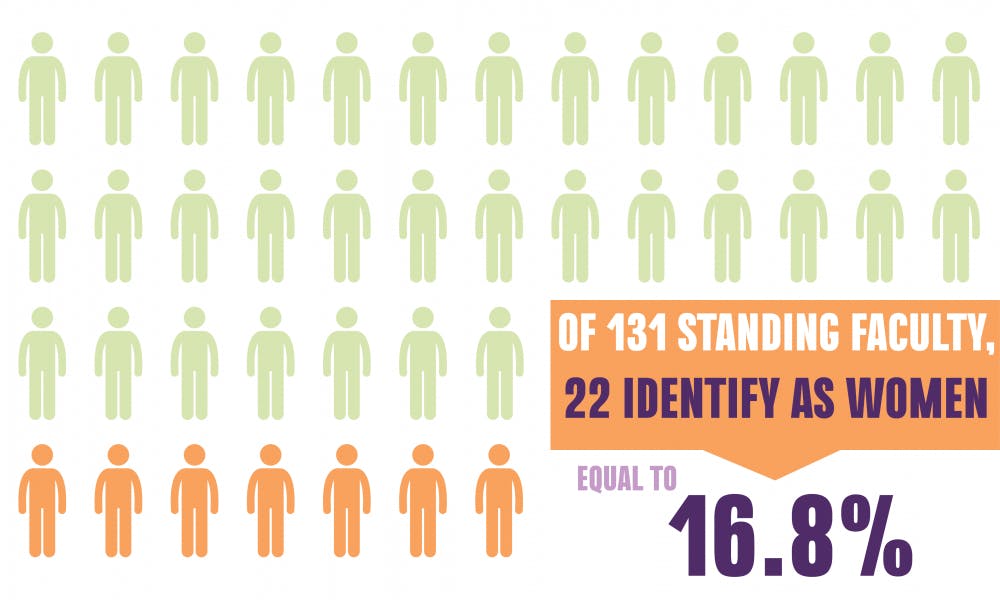As a part of the University's Action Plan for Faculty Diversity and Excellence, Penn released a report on the diversity breakdown among faculty across schools.
The five-year initiative was launched in 2011 and culminated in a Faculty Inclusion Report that was released in March 2017. In addition to various other trends, the report tracked the number of women in faculty positions in the School of Engineering and Applied Science. In 2011, women made up 12.3 percent of faculty in the Engineering School and in 2016, women made up 18.6 percent of faculty in the Engineering School, according to the report.
Yet, according to new data provided by the Engineering Director of Faculty Affairs Karen Brann, women now make up 16.7 percent of standing faculty in the Engineering School.
This seems to indicate a drop in the percentage of woman faculty members, from 18.6 percent in 2016 to 16.7 percent currently. The percent of woman faculty members in the Engineering School is the lowest when compared to all other schools in both 2011 and in 2016. There is no update on the current data for other schools.
This low percent of woman faculty members is evident in anecdotes, as many Engineering students say they have never had a woman professor. Others also say this low number sometimes creates an environment that allows for insensitivity towards women.
During the entirety of her time at Penn, Engineering sophomore Curie Shim said she has never had a female professor in any Engineering course that she has taken.
“It can be hard to find mentorship from faculty when a lot of them don’t understand your experiences or don’t have those experiences themselves,” Shim, who is also the chair of the Penn Association for Gender Equity, said.
The Electrical and Systems Engineering Department, in which Shim has taken a majority of her courses, has only two female identifying professors, according to data from the Engineering Director of Faculty Affairs Karen Brann.
RELATED:
Less than 10 percent of Engineering students are black or Latino. But this is changing.
New student board aims to support underrepresented engineers
Stephanie Tang, an Engineering junior who is the vice president of advocacy for Penn Women in Computer Science and is also pursuing her master's degree in robotics, said she once had a female professor in her Engineering Ethics class, but she has never had a woman teach any of her technical Engineering courses.
“It’s really strange to say that you’ve been learning and you’ve been in college for three years and never had a professor that looks like you,” Tang said. “There’s already a distance between students and professors and that can only widen the distance.”
Only six female standing faculty members teach in the Computer Science Department, but it still has the highest number of woman faculty out of all the departments in the school, according to Brann's data.
Brann said the Engineering School is actively trying to address its diversity issues. She added that the school has recently instituted and advertised "family-friendly" policies, such as extended maternity leave, in the hopes of attracting more female faculty and increasing retention rates.
“I think there’s a lack of overall dialogue around this because it’s so male-dominated so a lot of people barely, if at all, talk about the way that women are treated in the classroom,” Shim said.
Laura Stubbs, Engineering director of diversity and inclusion, said the Engineering School was “committed” to promoting faculty diversity. Although Stubbs indicated that the number of job offers made to women has increased in the past few years, she said she could not release the specific numbers.
Andrea Baric, Engineering senior and founder of FemmeHacks, said she has witnessed multiple instances of insensitivity in her CIS classes.
She recounted an instance in which one of her male professors had an all-female teaching staff and said he was “excited” about having the staff, adding that he “could say more about that, but I won’t.”
“It had sexual undertones, which was very strange to us. He might not have meant it that way, but people took it in that way,” Baric said. “You kind of face that all of the time and it gets really exhausting after a while.”
Vice Provost of Faculty Anita Allen said the University does not mandate a form of sensitivity or diversity training for all faculty.
Baric added that although these uncomfortable experiences are common, there are many men who are actively trying to promote and support diversity within the Engineering School.
Tang said she started meeting with the Director of the Master of Computer and Information Technology Chris Murphy and CIS Lecturer Swapneel Sheth to discuss diversity issues within the CIS faculty since the end of last semester. She said the group had discussed hosting a possible diversity summit and an event to celebrate the six female programmers who helped to create the ENIAC machine.
Allen noted that one of the barriers to hiring more female faculty members stems from the lack of women studying engineering. Approximately 40 percent of students in the Engineering School identify as women, according to Stubbs.
The faculty diversity report also noted a slight increase in the number of underrepresented minority groups within the Engineering faculty, from 7.5 percent to 8 percent throughout the years of 2011 to 2016.
Shim, who is also on the University Council's Committee for Diversity and Equity, said she has not heard of any specific initiatives or plans that Engineering administrators are taking to increase women and minority representation within the school’s faculty.
“I wish there was more transparency about what specific measures they’re taking or what goals they have because right now it seems like there’s a lot of people talking about it, but maybe not much being done or not letting students know,” Shim said.



